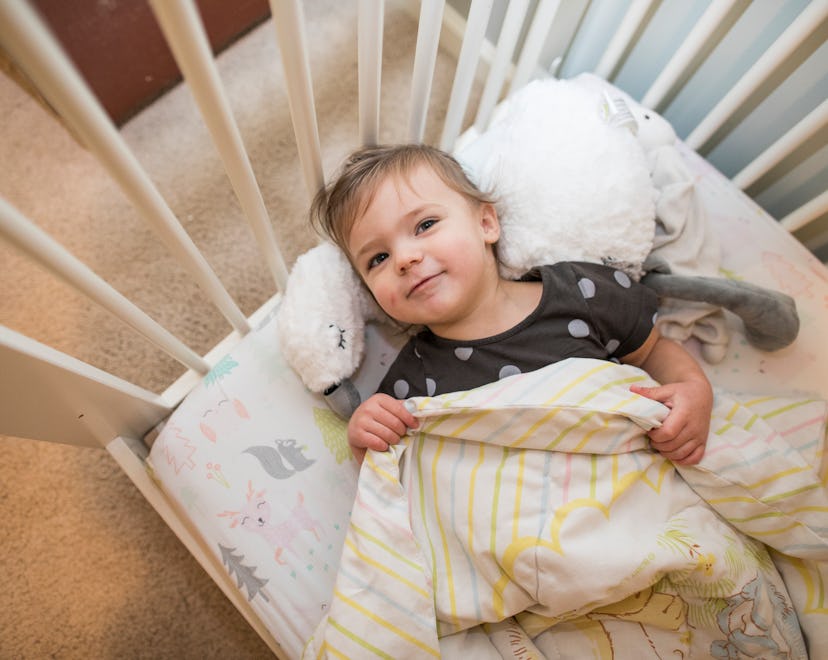Tots

The Cute Reason Why Toddlers Love To Sleep With The Blanket Over Their Face
Snug as a bug in a... wait, can you breathe?
Toddlers have all kinds of funny, cute, and downright terrifying quirks, from having an intense obsession with lining up all their toys, to crying so hard they throw up. Do you ever check on your sleeping toddler only to find they’re covered head to toe in their comforter (like, literally head to toe)? When you pull back the blanket, you see they’re breathing fine, even if they’re a little sweaty. But why do toddlers sleep with blankets over their heads anyway? Can that even be comfortable? Why does it happen every night and nap time? And most importantly, is it safe?
The good news is, experts say you can probably put your parental worries to bed, right alongside your sleeping toddler. And, you can also just opt out of using a blankie if it stresses you out.
Why your toddler sleeps with a blanket over their head
Turns out, toddlers feel more comfortable when they can control their surroundings, says Dr. Natasha Burgert, a Kansas-based pediatrician and spokesperson for the American Academy of Pediatrics (AAP). Making a blankie cocoon may just be another way of doing that. “Fundamentally, toddlers are self-centered creatures that crave control. Sleeping with items over their heads allows them to create their own comfort position when they sleep, creating that soothing sense of control,” she explains.
Is it safe for your toddler to sleep with a blanket over their head?
When asked whether or not parents should move the blanket out of the way if they notice that their toddler's face is covered, she wasn’t afraid to keep it real.
“Isn't that like trying to wake a sleeping bear? If they are comfortably resting, then I would not be concerned. A toddler has the ability to reflexively remove an obstruction from their face if it is threatening their breathing,” Burgert says.
But not everyone is comfortable with little ones’ airways potentially being blocked — parents or pros. Cynthia Dennis, RN, coordinator of Safe Kids Northeast Florida at Wolfson Children’s Hospital of Jacksonville, tells Romper in an interview that if questionable safety hazards can be avoided, why not avoid them?
“Footed PJs of an appropriate weight, so covers aren’t needed, would solve this problem," Dennis says. Burgert agrees that footed pajamas for 2- or 3-year-olds are practical because little ones tend to kick blankets off in their sleep anyway. If you happen to live in a temperate climate, you can maybe even skip the blanket altogether.
Safe sleep for toddlers
The AAP’s safe sleep guidelines — which include putting your little one in a bassinet, crib, or pack and play to sleep without any loose covers or pillows — only apply to babies up to 1 year old. So, when it comes to toddlers ages 1 and older, how can you keep them safe while they slumber?
Nemour’s Children’s Health pediatricians recommend children this age continue sleeping a secure crib until they begin trying to climb out. They add that it’s OK, after your baby turns 1 year old, to let them have a light blanket and small stuffed animal or lovey, but to avoid adding bigger items to their crib. They could turn that giant teddy bear into a step stool to swing a leg over their crib rail, and wind up falling out. If you’re concerned about them kicking off their blankets, or a light blanket not keeping them warm enough, they advise you dress them in thicker pajamas or a wearable blanket.
So, if your little one goes into full cocoon mode, you could just leave them that way. If that idea makes you feel on edge, perhaps it’s time to look into a sleep suit and some footie pajamas.
Experts:
Dr. Natasha Burgert, FAAP, board-certified pediatrician in Overland Park, Kansas, spokespokerson for the American Academy of Pediatrics, and writer at kckidsdoc.com
Cynthia Dennis, RN, coordinator of Safe Kids Northeast Florida at Wolfson Children’s Hospital of Jacksonville
This article was originally published on